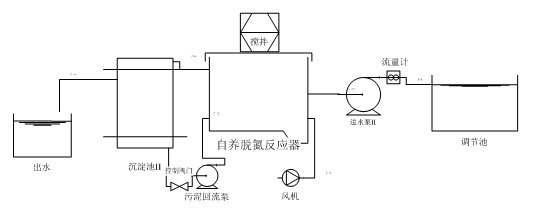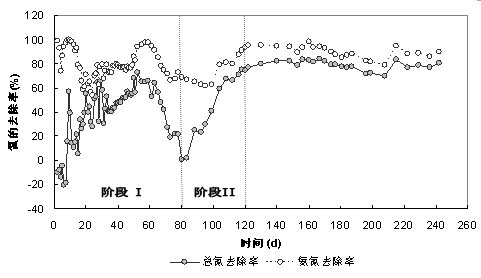Method for converting active sludge into autotrophic denitrified sludge based on mixed type continuous flow reactor
An activated sludge and autotrophic denitrification technology, applied in the field of sewage denitrification process treatment, can solve the problems of long cycle, complicated start-up process, unclear operation parameters, etc., to achieve good versatility and promotion space, simple and cheap equipment , The effect of stable long-term operation
- Summary
- Abstract
- Description
- Claims
- Application Information
AI Technical Summary
Problems solved by technology
Method used
Image
Examples
Embodiment 1
[0028] Use anaerobic sludge as seed sludge to feed the continuous flow reactor, (1) Preparation stage: sludge stabilization period, the purpose is to stabilize the sludge by aeration and remove organic matter and impurities. Add sludge into the denitrification reactor, add municipal sewage, the ratio of sludge to water is 1:5, fully aerate for 24 hours, continue to stir, run in batch mode for 1 day, and then drain 80%. (2) The first stage: add sodium bicarbonate buffer, mix at a ratio of 4g per liter of water, and maintain a pH value of 7.5-8.0 during the acclimation period; blast aeration, control DO at 1-0.5mg / L, stir and mix completely, Continuous drainage, VSS guaranteed at 1.5g / L or above, hydraulic retention time 1 week. At the same time, increase the concentration of ammonia nitrogen in the influent water every week, starting from 50mg / L to 100mg / L; The accumulation rate of nitrite is 70-80% or above, the removal rate of ammonia nitrogen is 80% or above, and the remova...
Embodiment 2
[0030] Use anoxic sludge as seed sludge to feed the continuous flow reactor, (1) Preparation stage: sludge stabilization period, the purpose is to stabilize the sludge through aeration and remove organic matter and impurities. Add sludge into the denitrification reactor, add municipal sewage, the ratio of sludge to water is 1:4, fully aerate for 36 hours, continue to stir, run in batch mode for 2 days, and then drain 75%. (2) The first stage: maintain the pH value of 7.8-8.0 during the acclimation period; blast aeration, DO control at 0.6mg / L, complete stirring and mixing, continuous drainage, and hydraulic retention time of 6 days. At the same time, increase the concentration of ammonia nitrogen in the influent water every 6 days, starting from 50mg / L to 100mg / L-200mg / L, and increase the ammonia nitrogen concentration in the influent water to 200-400mg / L after one month. The accumulation rate of nitrite is 80% or above, the removal rate of ammonia nitrogen is 90% or above, an...
Embodiment 3
[0032] Use the return sludge of the secondary settling tank as the seed sludge to feed the continuous flow reactor, (1) preparation stage: as above; (2) the first stage as above;: maintain the pH value of 7.8-8.0 during the water intake; Wind aeration, DO control at 1mg / L, complete mixing, continuous drainage, hydraulic retention time 7 days. At the same time, increase the concentration of ammonia nitrogen in the influent water every day, starting from 50mg / L to 100mg / L-200mg / L, and increase the ammonia nitrogen concentration in the influent water to 200-400mg / L after one month. The accumulation rate of nitrite is 80% or above, the removal rate of ammonia nitrogen is 90% or above, the removal rate of total nitrogen is 20%-25%, and the VSS is guaranteed to be 1.5g / L or above. Reach the 80th day and then enter the second stage of cultivation. (3) The second stage: add sodium bicarbonate buffer, mix at a ratio of 4g per liter of water, and maintain a pH value of 7.8-8.0 during a...
PUM
 Login to View More
Login to View More Abstract
Description
Claims
Application Information
 Login to View More
Login to View More - R&D
- Intellectual Property
- Life Sciences
- Materials
- Tech Scout
- Unparalleled Data Quality
- Higher Quality Content
- 60% Fewer Hallucinations
Browse by: Latest US Patents, China's latest patents, Technical Efficacy Thesaurus, Application Domain, Technology Topic, Popular Technical Reports.
© 2025 PatSnap. All rights reserved.Legal|Privacy policy|Modern Slavery Act Transparency Statement|Sitemap|About US| Contact US: help@patsnap.com



